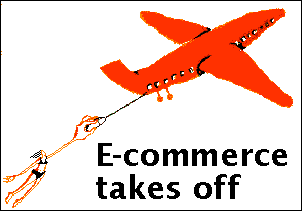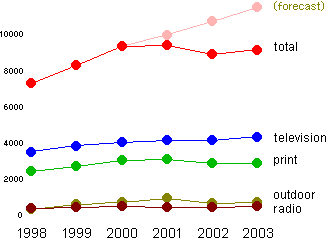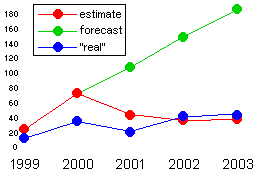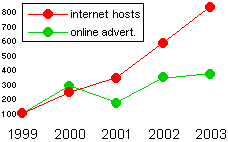Other articles on similar subjects
are published in English
in the monthly Offline column
|
 |
1. E-commerce fact and myth |
|
|
For ten years, almost every year, we’ve been hearing and
reading about the “takeoff” of electronic commerce.
Piles of books, articles, reports, online and in print.
Countless conferences, seminars, university teaching,
etcetera. Lots of hype, very rare accurate reporting of facts.
All of the projections and forecasts were wrong, in one
way or another. There were two basic mistakes in the concept
of an imaginary “new economy”. One is that anything
relating to information technology or online activity would
happen in a separate time frame – much faster than anything
else. That is just nonsense. The other is that new solutions in sales
and distribution would, or could, replace the existing systems. That
may be happening in a few cases, but not as widely (or as soon) as
it was expected.
But there are developments – and they aren’t small.
For several years The Economist has been wisely skeptical about
e-xaggeration. On May 15, 2004 it published a front-page
story titled E-commerce takes off.

This extensive report is based mostly on the
US market –
that is different from others for several reasons. One is,
obviously, size. Another is that mail order buying was widely
established long before there were computers or electronic
networks. More recently, twentyfive years ago, there were
online commercial services (that was eighteen years before
use of the internet became a widespread habit in American
households.) Of course there are e-commerce opportunities,
and facts, in Europe and in other parts of the world. But
it’s unwise to believe that they always happen in the same
way (and in the same time frame) as in the American market.
In 1999, at the peak of the stock exchange
“bubble”, there were grossly exaggerated
projections about the potential of e-commerce. In 2000 and
following years, with the bubble deflation and many “dot
com” collapses, there were equally exaggerated
perceptions of total failure. Of course there were successful
online businesses before the bubble, and they are still there
– including “classics” such as the Amazon
bookstore and Dell computers.
And, of course, there are (relatively) new developments.
According to the Economist report transactions on E-Bay in
2003 were worth 14 billion dollars. The single largest
category, by amount of money, was second-hand cars.
(There are other developments in the car business. Online
bookings for rentals are increasing, while people use
websites to collect information before they go to a dealer to
buy a new car).
It’s no surprise that travel is one of the fastest
growing areas in online business. This is not only because
people and companies find it convenient to compare and book
directly, but also because airlines like the idea of
bypassing travel agents and saving the cost. There also
relevant increases in the online booking of hotels, organized
holidays, etcetera.
In retail many Americans are doing online what their
grandparents did by mail-order (or phone). But “brick
and mortar” dealers aren’t losing business. Online
retail sales in the United States rose to 5.5 billion dollars
in 2003. That’s a large figure, but it’s only 1.6 percent of
total retail. Also in the case of books Amazon’s success
isn’t threatening the survival of neighborhood bookstores or
large distributors.
In other areas, however, traditional shops are losing
ground. In addition to travel agents, there is also the case
of music.
Of course (for all sorts of goods and services, not only
cars) there is widespread “window shopping” online.
It’s probably an exaggeration to say that half the people in
Europe who have an internet connection use it to check before
they go out to buy, but it’s a fact that the influence of
information on purchase decisions is much larger than direct
online sales.
It has always been difficult to measure the actual volume
of business-to-business online transactions. It’s pretty
large, but in some areas it isn’t growing. For instance The
Economist reports that several companies are disappointed
with the results of automated purchasing systems and are
going back to cooperation with experienced and trusted
partners. However there are cases where suppliers are forced
to go through the buyer’s standardized online procedures. In
the case of WalMart this involves purchases worth 250 billion
dollars.
It’s large, complex and changing picture. But it’s clear
that e-commerce exists – and it’s growing.
It’s surprising, however, that one of the most reliable
magazines in the word made, this time, a mistake. It isn’t in
the report. It’s in the headline. There is no
“takeoff”, no abrupt change from rolling on a
runway to flying. In spite of the hype and the
disappointments, e-commerce has bee growing consistently for
over twenty years. There will be more developments and
changes. Some will be slow, some will be faster. But people’s
habits and behaviors don’t change as quickly as the gee-whiz
prophets wanted us to believe.
In all this there are three basic facts.
- Technologies work when they fit people (not
vice versa.)
See The stupidity of
technologies.
- The key to success is service – carefully tailored, and
constantly verified over time, to meet the real needs and
desires of customers.
- All sound business, especially online, is built on
mutual trust. It takes time and care to establish and develop
strong relationships.
back to top
|
 |
2. The “bubble” misconception |
|
|
There are still discussions on the “financial
bubble”, but they continue to be based, most of the
time, on a misconception. It wasn’t caused by the
development of information and communication technologies.
Financial adventures and collapses, often combined with
scams and swindles, had happened in several different
situations – and a long time earlier (see
“Robber barons”
aren’t new.) In the last two decades of the twentieth
century there were some new developments, with wild stock trading and
financial trickery, as well as corporate strategies based on
financial deals rather than effective management.
The overwhelming trend of mergers and acquisitions, with
all sorts of financial maneuvering, had caused serious
diseases in the basics of the economy, long before they were
offered a new opportunity by the venture capital adventures
based on the delusion that a “new economy” was
going to develop at a much faster speed that was
realistically conceivable (see Is
hasty really fast? and Do
androids dream of electric money?)
It became clear later, with the collapse of large
companies in other fields, that the problem had been there
for several years – and its origins were on a wider scale
that just the “high tech” sector.
The hype, of course, had been stupid. But when the crunch
came some strange things happened. E-business, and the
internet as a whole, were seen as collapsing (facts prove
that they weren’t, and they continued to grow.)
And, at the same time, there was a manipulated craze for online
stock trading – that added to the speculative mania and
financial swindles. The consequences are sadly obvious.
At the same time (and that’s no coincidence) there was a
dramatic loss of competence, dedication and motivation in
many companies, with a deterioration of quality and
service.
The time has come to go back to real business and real
values. Offline, online or both.
back to top
|
 |
3. Advertising in Italy (online and off) |
|
|
In issue 67 (December 2002) we had
seen that adversiting expenditure in Italy in 2001 and 2002 was well
below the industry’s expectations. A review of this subject, with
updates limited to one country, may not be interesting for international
readers. But some of the symptoms are not very different from what is
happening in other parts of the world.
According to data published in April 2004 by Intermatrix-Astra, on
behalf of the advertisers' association, there was a slight increase in 2003,
but the total remained below the level that had been reached in year 2000.
This table shows advertising investmens in mainstream media
and in the internet in the last five years.
Advertising
investments in Italy
1999-2003
(millions of euros)
| |
1999 |
2000 |
2001 |
2002 |
2003 |
| Television |
3,837 |
4,047 |
4,139 |
4,150 |
4,335 |
| Print |
2,698 |
3,304 |
3,086 |
2,874 |
2,864 |
Outdoor |
598 |
688 |
915 |
669 |
687 |
| Radio |
431 |
499 |
458 |
440 |
470 |
| Movie theaters |
48 |
54 |
69 |
60 |
75 |
| Total * |
8,303 |
9,354 |
9,389 |
8,893 |
9,155 |
| Internet |
25 |
73 |
44 |
88 |
93 |
* Including
production costs
Italy has always had a higher use of tehevision advertising,
in proportion to other media, than most other European countries.
That unbalance is getting worse, with television up 7 percent
compared to 2000 while newspapers and magazines are down 33 percent.
Investmnìments in all forms of business communication are decreasing
– and substantially below growth expectations. The picture,
for advertising, is summarized in this graph.
Advertising in Italiy
1998-2003
(millions of euros)

The
“pale” line for the total at the top
shows the trend as it was
porjected in January 2001
Current projections indicate slight growth in 2004-2005 and
are somewhat more optimistic about 2006 – when they expect
to reach the level that in the past had been predicted for 2001.
Advertising expenditure in Italy in proportiion to the size of
its economy (GNP) are considerably
below the average in Western Europe.
The next table shows advertising by type of productor service
in 2003 according to Nielsen (including only categories with more
than 2 percent of the total).
Advertising
in Italy by category – 2003
(percentages of total)
| Food and drink |
25.3 |
| Motorcars |
11.8 |
| Personal care and toiletries |
9.4 |
| Telecommunication |
8.2 |
| Clothes |
6.3 |
| Publishing and media |
6.2 |
| Household goods |
4.1 |
| Real estate |
3.8 |
| Distribution |
3.5 |
| Finance and insurance |
3.4 |
| Health care |
2.9 |
| Tourism and travel |
2.3 |
| Personal objects |
2.1 |
Packaged goods (especially food) are back in the lead.
"High tech" products, that were advertising heavcily in
1999-2000, now are much less visible –woth the only
esception of "telecommunications" (mostly cellular
phones, with telcoms investing heavily to sell new gimmicks
in a mature and highly profitable market.) If we combine
categpories such as “photography and information
technology” and “audio video” the sum now
barely reaches 2 percent of the total. Also banks were more active
in communication a few years ago than they are now.
At the time of the “bubble” advertising expeniìtures in Italy,
as in many other places, by “new technology” compamies
were aimed at attracting venture capital or lifting stock prices rather than
producing results in the marketplace. And that accelerated theor demise.)
Online advertising appers to have gworwn in 2003 to about
one percent of the totalo (but we must always remember that about
half of that is bartering inside the sector, so real money is about
0.5 percent – probably less, because web ads are often gieavways
in the negotiation of more expensive media). That is enpormpously
less that was expected four or five years ago, but a little
more that was projected more recently, as we see in this graph.
Online advertising
in Italy
1999-2003
(millions
of euros)

The green line
shows the forecast
hat was made in January 2001.
The red
line is the projection
by the same source in 2002.
There appears to be slight, and unexpected, growth in 2002-2003.
In any case web advertising is a very small part of online business activity
The next graph compares the evolution of web advertising with
the total growth of online activity in Italy.
Internet hosts
and online advertising in Italy
1999 = 100

Of course not all online activity is business. But it’s clear that
Italy’s general development iin the internet (see
European and
international data) is much
larger, and growing much faster, than it would appear by loohing
at the tiny figures of advertising on websites.
Earlier comments on this subject are in issues
6, 16,
44, 56
and 67.
|
|